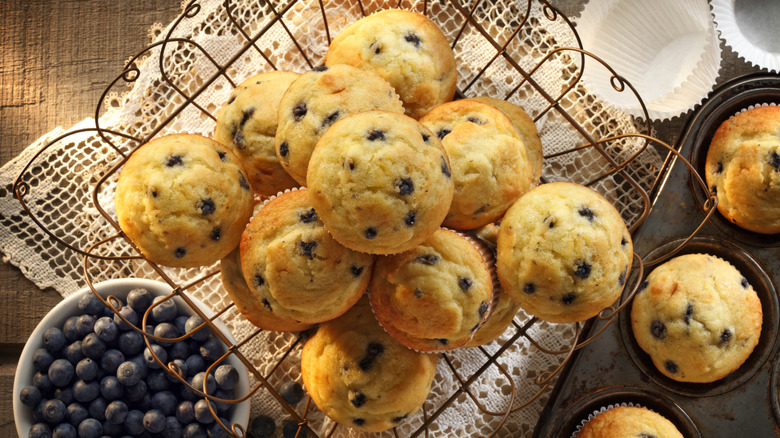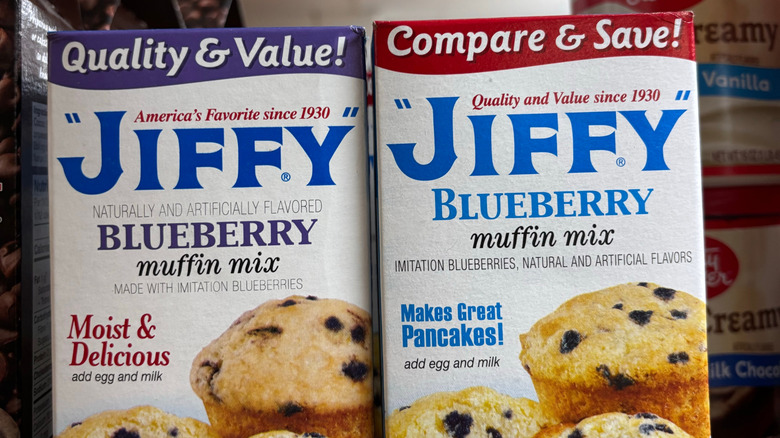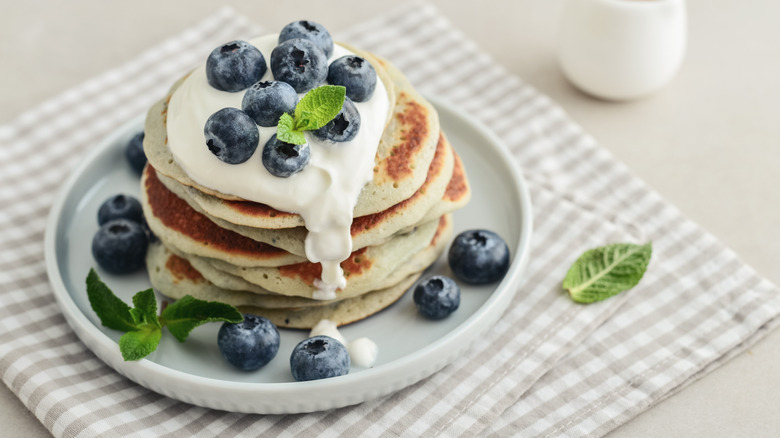This Is What's Really In Imitation Blueberries
When you pick up a box of blueberry muffin mix at the store, you expect it to contain a few things. Namely, some sort of simple batter mix and, well, blueberries. The thing is, despite these packages having the word "blueberry" printed across the front in large letters, many of them don't contain even a trace of real fruit. Instead, they contain an artificially colored and flavored product often referred to by names like "blueberry bits."
As for what exactly is in these artificial blueberry nuggets, it varies from brand to brand, but they all follow a similar scheme. The fake blueberry chunks are made from various sugars, starches, and oils, which are colored with blue and red dyes and flavored with an artificial blueberry flavor made from, according to one patent, "linalool and a flavorant selected from the group consisting of trans-2-hexenol, trans-2-hexenal, cis-3-hexenol, cis-3-hexenal and combinations thereof."
Now, this is not to say that the "blueberry" products in your pantry are unsafe to consume. All of these products are approved by the FDA and are considered to be perfectly safe. This is not even meant to discourage you from eating artificial blueberries, only to ensure that you are aware of what you're getting. (In fact, the Dunkin' Donuts blueberry cobbler coffee is pretty delicious, and there's no way that crystal clear syrup is made with real blueberries.) That said, we do have some advice for how to ensure the blueberry products you buy contain the real thing.
How to spot imitation blueberry products
Fortunately, it's actually pretty easy to tell which of these "blueberry" products aren't using the real thing, even if you didn't grow up in the Western U.S. state that grows the most blueberries. Products featuring artificial blueberries should say it somewhere on the packaging. It is certainly not put front and center like the misleading word "blueberry" is, but it is typically there in smaller print.
If the package doesn't explicitly say "artificial blueberries" on the front, the next place to look is the ingredients. If the ingredients list features blueberries, you may be looking at the real deal — though not necessarily. Some products include a mixture of blueberries as well as blueberry-like adjuncts.
To achieve the expected flavor and appearance of blueberries, some companies have done things like combine blueberry pieces or other fruits with sweeteners, gels, flavorings, and colorants to achieve a convincing simulacrum of the real thing. Check the ingredient list for fruits you don't expect, but especially for blue and red dyes (and sometimes green). You will find these dyes in many artificial blueberries, so it can be a good indicator that the company is trying to pull a fast one on you.
As mentioned above, artificial blueberries are not necessarily bad to eat. Many processed foods contain artificial flavors or colors. But it is certainly worth looking more closely at how the nutritional values stack up between products with real blueberries versus those that use the artificial option.
Comparing products with artificial versus real blueberries
Artificial blueberries are often found in cereals, bread, granola bars, bagels, yogurts, and various dry mixes for baked goods. Fortunately for our comparison, Betty Crocker has two blueberry muffin mixes on the market, one containing artificial blueberries (Betty Crocker Blueberry Muffin Mix) and the other made with the real thing (Betty Crocker Wild Blueberry Muffin and Quick Bread Mix). As far as nutrition goes, the two mixes are pretty similar. Blueberry muffins are not exactly a health-forward foodstuff, and the quantity of fruit or faux-fruit present doesn't have a significant effect beyond appearance and flavor.
One serving of the artificial blueberry muffins has 250 calories, 5 grams of fat, 48 grams of carbohydrates (including 23 grams of added sugar), and 2 grams of protein. By comparison, one serving of the real thing has 230 calories, 2.5 grams of fat, 48 grams of carbohydrates (including 23 grams of added sugar), and 3 grams of protein. As you can see, the muffins made with real blueberries are slightly lower in calories and have half the fat, but are otherwise quite similar.
While it feels like something out of a science fiction story that you might pick up a box of blueberry muffin mix at the store that contains only nuggets designed to mimic that fruit, in the end it doesn't make too much difference nutritionally. But, if you'd rather eat real fruit (who wouldn't?), now you know what to be on the lookout for. Or, you know, you could always just grab a fast food blueberry muffin and save yourself some worry.


